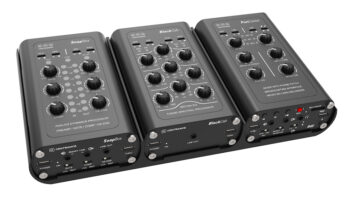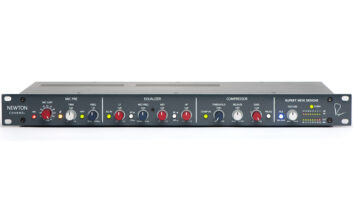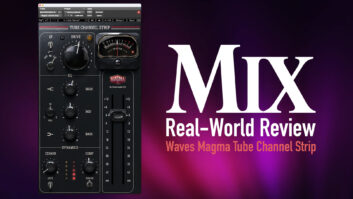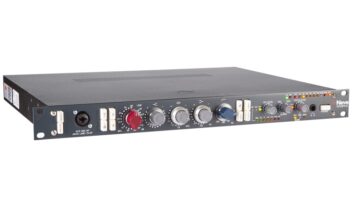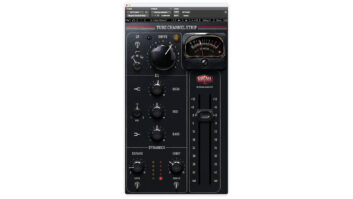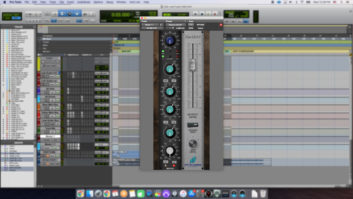Joemeek’s new “Q” channel strip series maintains that classic Joemeek ’60s midrange boost and presence, while better integrating into today’s modern analog/digital studios. Upgrades such as a Burr Brown mic amp with transformer coupling, optical compressor, a toroidal power supply and digital outputs are a few of the improvements.
The next generation of Meeks includes the threeQ, sixQ, twinQ and the oneQ (reviewed here). Out of the bunch, the twinQ is the only dual-channel unit, but the oneQ adds an enhancer and de-esser, making it the line’s most full-featured processor.
GETTING IN AND OUT
The rear of the unit is loaded with options. Under Channel 1 are two inputs: a 1.2k-ohm XLR mic input and a dedicated ¼-inch TRS line input. Analog outputs are simultaneously fed through a standard XLR or ¼-inch TRS jack. The ¼-inch is switchable between +4dBu or -10dBv levels. There is also an unbalanced TRS insert (pre-compressor/EQ).
The digital interface includes BNC word clock inputs and outputs. An XLR provides AES3 digital protocol, while S/PDIF format is delivered through optical or RCA connections. All standard sampling rates of 44.1 to 96 kHz (16- or 24-bit) are supported via rear panel switches. A front panel switch would have been more user-friendly.
TAKE ONE
During tracking sessions, setting the oneQ’s levels was a breeze with the large VU meter, which multitasks for mic pre, gain reduction and channel output levels. There is an ancillary XLR mic input on the front and a ¼-inch instrument input for DI access. The mic pre section has switches and LEDs for all anticipated controls, including 48V, 20dB pad, line input selection, polarity reversal and an 80Hz highpass filter. There is also an Iron switch that introduces a transformer into the mic circuit.
My tracking session featured an AEA R84 ribbon mic on an acoustic guitar. I found myself cranking the gain about 55 to 60 dB for proper levels, inducing some unwanted noise. The results were good but not very inspiring. In a drum session, I placed a RØDE NTK about 18 inches outside the kick, and the oneQ shined. I used the transformer in the circuit, giving me a well-defined, full kick sound. Later, the oneQ was combined with a Neumann TLM 127 to capture a tuba. In this application, the Iron switch made all the difference, giving the tuba a nice, low midrange tone and robust presence.
On aggressive rock vocals, I used a large tube condenser mic and achieved good results. The oneQ produced plenty of high midrange and maintained dynamic control with the optical compressor (4:1 ratio with 6 dB of gain reduction). The Iron setting again made a huge difference, adding more body and presence to the vocal. Quite frankly, the Iron remained in the circuit from here on out. The oneQ also excelled as a bass DI. I plugged straight into the front, used a little compression, ran through the Meequalizer EQ (+3 dB @ 80 Hz) and had a nice, thick tone for the song.
DYNAMICS
For dynamics, the oneQ features an optical compressor, EQ (Meequalizer), enhancer and a de-esser. The optical compressor features compress (threshold), slope (ratio), attack, release and makeup gain controls. It can be switched either pre- or post-EQ. During some pop rock mix sessions, the combination of the optical compressor and the Meequalizer gave uninspiring bass DI tracks new life. On bass, the enhancer added character to the upper harmonics.
The Meequalizer is a 4-band peaking EQ. High and low frequencies are selectable between 7 kHz/14 kHz and 80 Hz/120 Hz, respectively, while the HMF and LMF are sweepable. All four bands allow a boost or cut of 15 dB and have a Q value of 0.9 (1.6 octaves). While cutting and mixing electric rhythm guitars, a 4dB boost at 7 kHz nicely accentuated the pick action and tucked the Les Paul properly into the overall mix.
SUMMED UP
Distributor PMI’s upgrades to the line pay off. The only issue I had was not having enough gain with a ribbon mic during a tracking session. The mic pre was clean, and with the transformer, it had a lot of personality. While mixing guitars and bass, I found myself experimenting with the Meequalizer with good musical results.
The optical compressor could be both traditional and very expressive. Throw in every digital and analog I/O, word clock capabilities, a good pre, dynamics galore and an attractively revamped front panel interface, and the oneQ is definitely a full-featured channel strip. With a list price of only $799, the oneQ is a steal.
Joemeek, 877/JOEMEEK, www.joemeek.com.
Tony Nunes ([email protected]) is an audio engineer and educator based out of Phoenix.
Click on the links below to learn more about the rest of the Q Channel Strip series:
Click here to download the oneQ Channel Strip manual.
